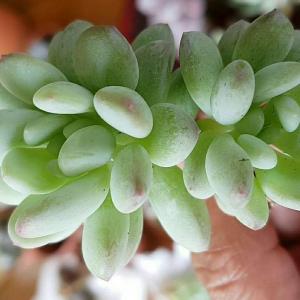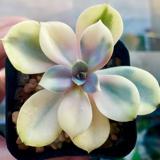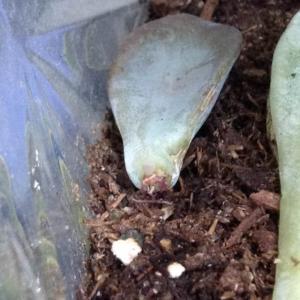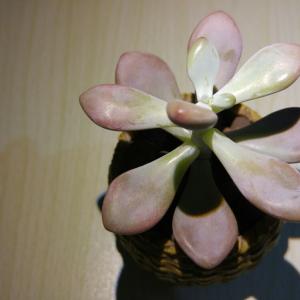求助
chelzeeeee
2017年10月23日

Hello! Please help my identify what type of Graptopetalum this is. Thanks!


0
0
文章
Dummer. ゛☀
2017年10月01日

Scientific Name
Graptopetalum superbum (Kimnach) Acev.-Rosas
Common Names
Beautiful Graptopetalum
Synonyms
Graptopetalum pentandrum subsp. superbum
Scientific Classification
Family: Crassulaceae
Subfamily: Sedoideae
Tribe: Sedeae
Subtribe: Sedinae
Genus: Graptopetalum
Description
Graptopetalum superbum forms 5 inch (12.5 cm) wide flat open rosettes with fleshy, thick pale gray-lavender to pink colored leaves that cluster in rosettes at the end of thick stems. Old plants have been noted with stems as long as 7 feet (2.1 m) but more typically this plant remains fairly compact, especially when grown in full sun. In late winter to early spring arise up to 2 foot (60 cm) tall, open multiple-branched inflorescences holding dainty flowers with pale yellow petals with red markings on the tips, and with red sigma lobes and stamens.
How to Grow and Care
The rules for Graptopetalums care are similar to those for most succulents. All require lots of sun to look their best. They require gritty porous soil with excellent drainage. Water regularly over the summer months letting the soil dry out between waterings. Minimal water is required over winter. Overwatering is a cause of root rots and the plant can get several pest infestations. Fertlize once during the growing season with a balanced fertilizer diluted to ¼ strength.
The Graptopetalums are generally easy to propagate, by seeds, leaf cuttings or offsets. Any rosette that breaks off has the potential to root and start a new plant. Even a leaf that drops off will root below the parent plant and produce a new rosette quickly.
Graptopetalum superbum (Kimnach) Acev.-Rosas
Common Names
Beautiful Graptopetalum
Synonyms
Graptopetalum pentandrum subsp. superbum
Scientific Classification
Family: Crassulaceae
Subfamily: Sedoideae
Tribe: Sedeae
Subtribe: Sedinae
Genus: Graptopetalum

Description
Graptopetalum superbum forms 5 inch (12.5 cm) wide flat open rosettes with fleshy, thick pale gray-lavender to pink colored leaves that cluster in rosettes at the end of thick stems. Old plants have been noted with stems as long as 7 feet (2.1 m) but more typically this plant remains fairly compact, especially when grown in full sun. In late winter to early spring arise up to 2 foot (60 cm) tall, open multiple-branched inflorescences holding dainty flowers with pale yellow petals with red markings on the tips, and with red sigma lobes and stamens.

How to Grow and Care
The rules for Graptopetalums care are similar to those for most succulents. All require lots of sun to look their best. They require gritty porous soil with excellent drainage. Water regularly over the summer months letting the soil dry out between waterings. Minimal water is required over winter. Overwatering is a cause of root rots and the plant can get several pest infestations. Fertlize once during the growing season with a balanced fertilizer diluted to ¼ strength.

The Graptopetalums are generally easy to propagate, by seeds, leaf cuttings or offsets. Any rosette that breaks off has the potential to root and start a new plant. Even a leaf that drops off will root below the parent plant and produce a new rosette quickly.
3
2
文章
Miss Chen
2017年09月22日

La Graptopetalum bellum es una planta suculenta que pertenece a la familia de las crasuláceas. Originaria de México presenta una estructura de rosetas y una floración ciertamente llamativa. También veremos en muchos sitios que la denominan Tacitus bellum, los especialistas la han clasificado de forma cambiante en ambos géneros, Tacitus y Graptopetalum.
Es una planta que alcanza una altura de tan sólo 7,5 cm aproximadamente y el diámetro de sus rosetas está sobre los 10 cm. Es una planta pequeña por tanto que queda muy bien cuando la cultivamos en maceta. Las flores tienen forma de estrella de cinco puntas y un diámetro de 2,5 cm, son de color rosa oscuro o rojo y se alzan unos 10 cm sobre las rosetas de hojas.

Como la mayoría de las plantas suculentas requiere un suelo poroso y bien drenado, necesita también mucho sol y un buen control del riego pues un exceso de humedad puede provocar la pudrición de sus raices. Podemos añadirle un cuarto de la cantidad habitual de fertilizante para plantas de maceta en la época de crecimiento. Su propagación es muy sencilla y se puede hacer por esquejes, semillas o partición. Los esquejes pueden tomarse de cualquier parte de la planta, incluso de las hojas.

Las flores de la Graptopetalum bellum duran varias semanas. En invierno guardaremos la planta dentro de casa si vivimos en un lugar muy frío, soporta temperaturas de hasta -4ºC. Volviendo al riego, es importante regar sólo cuando la capa superior del sustrato se ha secado bien, al menos unos centímetros deben estar secos. El agua mejor que esté templada, no excesivamente fría. En invierno hay que reducir el riego a la mínima expresión.

Mucha gente no consigue que florezca el Graptopetalum, se debe a tenerlo dentro de casa con una temperatura elevada. Esta planta sólo florece si pasa al menos un mes hibernando a una temperatura de 15ºC. En cuanto a plagas y enfermedades hay que tener vigiladas a las cochinillas que es su mayor enemigo.
Es una planta que alcanza una altura de tan sólo 7,5 cm aproximadamente y el diámetro de sus rosetas está sobre los 10 cm. Es una planta pequeña por tanto que queda muy bien cuando la cultivamos en maceta. Las flores tienen forma de estrella de cinco puntas y un diámetro de 2,5 cm, son de color rosa oscuro o rojo y se alzan unos 10 cm sobre las rosetas de hojas.

Como la mayoría de las plantas suculentas requiere un suelo poroso y bien drenado, necesita también mucho sol y un buen control del riego pues un exceso de humedad puede provocar la pudrición de sus raices. Podemos añadirle un cuarto de la cantidad habitual de fertilizante para plantas de maceta en la época de crecimiento. Su propagación es muy sencilla y se puede hacer por esquejes, semillas o partición. Los esquejes pueden tomarse de cualquier parte de la planta, incluso de las hojas.

Las flores de la Graptopetalum bellum duran varias semanas. En invierno guardaremos la planta dentro de casa si vivimos en un lugar muy frío, soporta temperaturas de hasta -4ºC. Volviendo al riego, es importante regar sólo cuando la capa superior del sustrato se ha secado bien, al menos unos centímetros deben estar secos. El agua mejor que esté templada, no excesivamente fría. En invierno hay que reducir el riego a la mínima expresión.

Mucha gente no consigue que florezca el Graptopetalum, se debe a tenerlo dentro de casa con una temperatura elevada. Esta planta sólo florece si pasa al menos un mes hibernando a una temperatura de 15ºC. En cuanto a plagas y enfermedades hay que tener vigiladas a las cochinillas que es su mayor enemigo.
0
1
文章
Dummer. ゛☀
2017年09月21日

Graptopetalum is a small genus of the family Crassulaceae. They are perennial succulent plants and native to Mexico and Arizona. Their leaves vary in colour from silver-grey to pink to waxy green, and are often speckled. They all have thick leaves forming rosettes with star-shaped flowers from white to pink on long stems. All require lots of sun to look their best. They are similar looking to Echeverias, although they are generally considered closer to Sedums.

Growing Conditions
The rules for Graptopetalums care are similar to those for most succulents. Container-bound plants thrive in a mixture of peat, sand or other grit, topsoil and a little bit of compost. Full sun is the best situation but they will also grow in partial sun with slightly rangy results.
Graptopetalums need excellent drainage and moderate water. You can tell when to water by sticking your finger in the soil. If it is dry several inches down or the fleshy leaves are looking shriveled, you should water. Overwatering is a cause of root rots and the plant can get several pest infestations.

Propagation
The Graptopetalums are generally easy to propagate, by seeds, leaf cuttings or offsets. Any rosette that breaks off has the potential to root and start a new plant. Even a leaf that drops off will root below the parent plant and produce a new rosette quickly. The new plant feeds off the leaf until it shrivels up and falls off. By then the new little ghost plant has rooted and sprouted new leaves.

Grower’s Tips
Summer growers. Graptopetalums require gritty porous soil with excellent drainage. Water regularly over the summer months letting the soil dry out between waterings. Minimal water is required over winter. Fertlize once during the growing season with a balanced fertilizer diluted to ¼ strength. All do best in sun or part sun excluding Graptopetalum bellum which prefers light shade.

Growing Conditions
The rules for Graptopetalums care are similar to those for most succulents. Container-bound plants thrive in a mixture of peat, sand or other grit, topsoil and a little bit of compost. Full sun is the best situation but they will also grow in partial sun with slightly rangy results.
Graptopetalums need excellent drainage and moderate water. You can tell when to water by sticking your finger in the soil. If it is dry several inches down or the fleshy leaves are looking shriveled, you should water. Overwatering is a cause of root rots and the plant can get several pest infestations.

Propagation
The Graptopetalums are generally easy to propagate, by seeds, leaf cuttings or offsets. Any rosette that breaks off has the potential to root and start a new plant. Even a leaf that drops off will root below the parent plant and produce a new rosette quickly. The new plant feeds off the leaf until it shrivels up and falls off. By then the new little ghost plant has rooted and sprouted new leaves.

Grower’s Tips
Summer growers. Graptopetalums require gritty porous soil with excellent drainage. Water regularly over the summer months letting the soil dry out between waterings. Minimal water is required over winter. Fertlize once during the growing season with a balanced fertilizer diluted to ¼ strength. All do best in sun or part sun excluding Graptopetalum bellum which prefers light shade.
1
1
成长记
greenwhalepinkshark
2017年09月15日

I new added a "Graptopetalum paraguayense twins!" in my "garden"


2
0




















